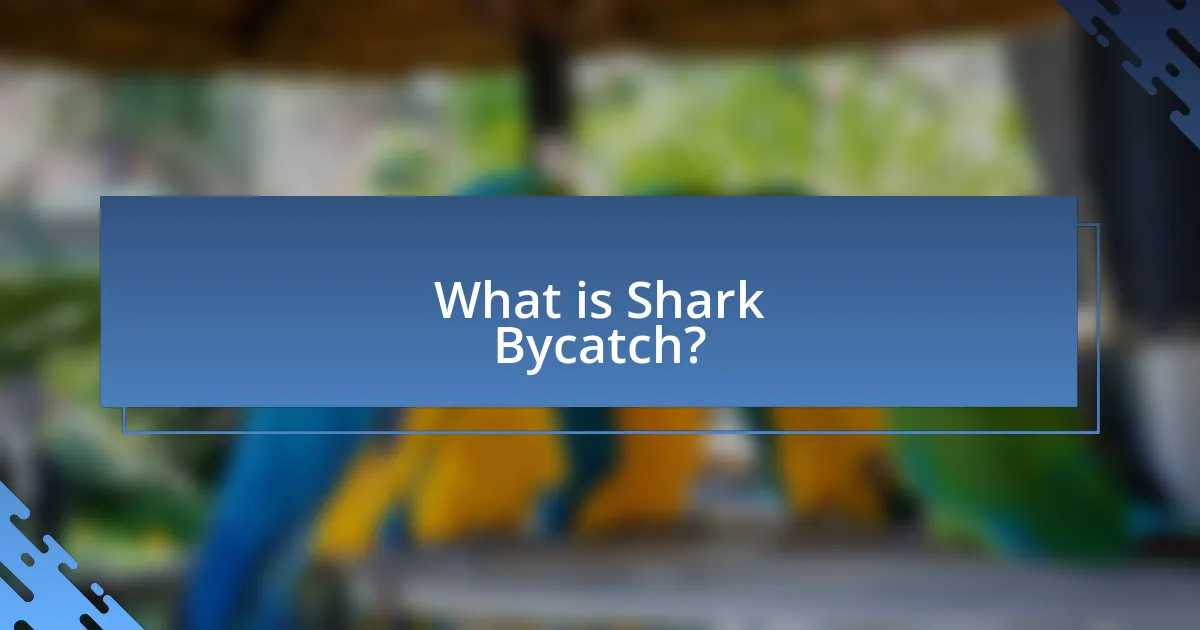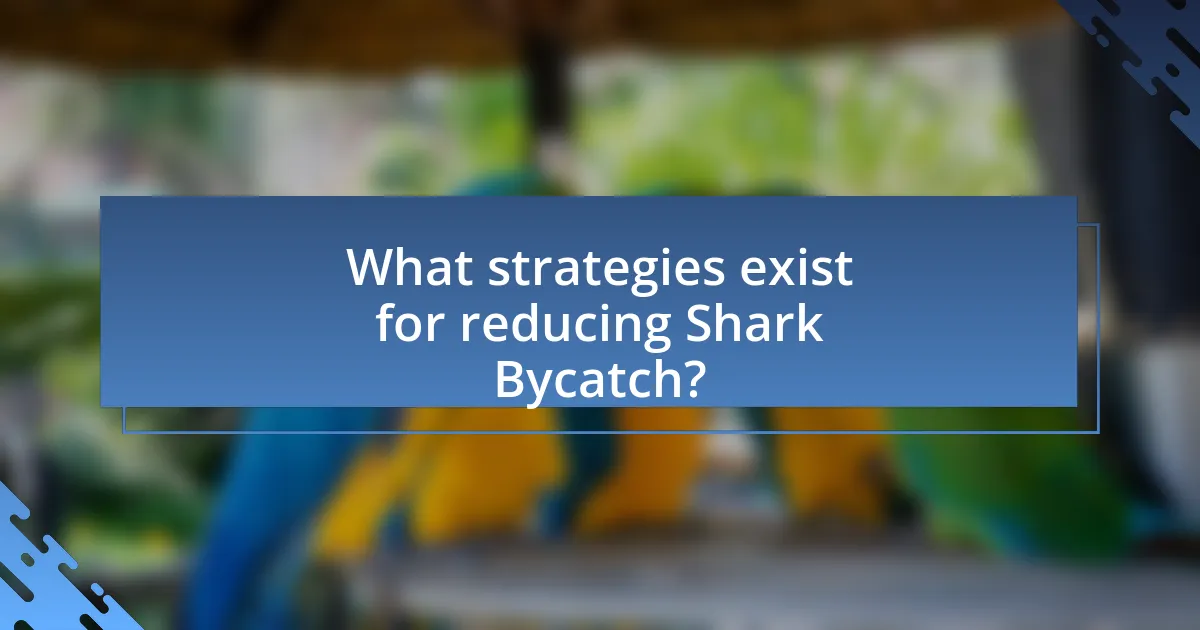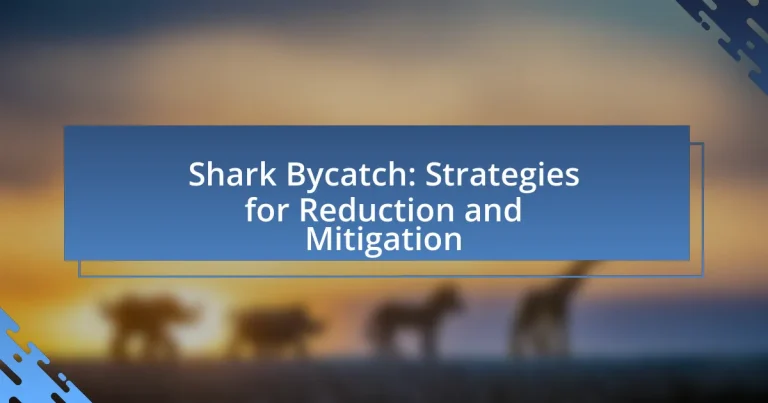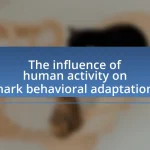Shark bycatch refers to the unintentional capture of sharks during fishing activities aimed at other species, significantly impacting shark populations and marine ecosystems. This article examines the causes and consequences of shark bycatch, including the fishing methods and gear that contribute to the issue, as well as the ecological and economic implications. It also explores strategies for reducing bycatch, such as gear modifications, regulatory measures, and educational initiatives, highlighting the importance of collaborative efforts among stakeholders to promote sustainable fishing practices and protect shark populations.

What is Shark Bycatch?
Shark bycatch refers to the unintentional capture of sharks during fishing activities targeting other species. This phenomenon occurs in various fishing methods, such as longlining and trawling, where sharks are caught alongside commercially sought fish. According to the Food and Agriculture Organization, bycatch can account for up to 40% of total catch in some fisheries, leading to significant declines in shark populations and disrupting marine ecosystems.
How does Shark Bycatch occur in fishing practices?
Shark bycatch occurs in fishing practices primarily through the use of nets and longlines that unintentionally capture sharks along with target species. These fishing methods often lack selective measures, leading to the incidental catch of non-target species, including various shark species. For instance, studies have shown that longline fishing can result in bycatch rates of up to 50% for certain shark species, highlighting the significant impact of these practices on shark populations.
What types of fishing gear contribute to Shark Bycatch?
Various types of fishing gear contribute to shark bycatch, including gillnets, longlines, and trawl nets. Gillnets entangle sharks as they swim through the water, leading to accidental capture. Longlines, which consist of a main line with multiple baited hooks, often catch sharks along with target species. Trawl nets, used for catching fish at various depths, can inadvertently capture sharks in their sweeping action. Studies indicate that these gear types are significant contributors to the global shark bycatch problem, with estimates suggesting that millions of sharks are caught unintentionally each year.
How do fishing methods impact the rate of Shark Bycatch?
Fishing methods significantly impact the rate of shark bycatch, with certain techniques leading to higher incidental capture rates. For example, longlining, which involves using a main line with numerous baited hooks, has been shown to result in substantial shark bycatch, accounting for up to 30% of total catch in some fisheries. In contrast, methods like pole-and-line fishing or using circle hooks can reduce bycatch rates, as they are designed to target specific species and minimize the capture of non-target species, including sharks. Studies indicate that implementing bycatch reduction devices and modifying gear can further decrease shark bycatch, demonstrating that the choice of fishing method is crucial in managing and mitigating the impact on shark populations.
Why is Shark Bycatch a concern for marine ecosystems?
Shark bycatch is a significant concern for marine ecosystems because it disrupts the balance of marine food webs and threatens shark populations, which are crucial for maintaining ecosystem health. Sharks play a vital role as apex predators, regulating the populations of prey species and contributing to the overall biodiversity of marine environments. The removal of sharks through bycatch can lead to overpopulation of certain species, resulting in negative cascading effects on the ecosystem. For instance, studies have shown that the decline of shark populations can lead to an increase in smaller fish species, which may overgraze on seagrass and coral reefs, ultimately harming these critical habitats.
What are the ecological consequences of Shark Bycatch?
Shark bycatch leads to significant ecological consequences, primarily through the disruption of marine ecosystems. The unintended capture of sharks, which are apex predators, can result in imbalances within the food web, as their absence allows prey populations to proliferate unchecked. This can lead to overgrazing of essential habitats, such as seagrass beds and coral reefs, ultimately diminishing biodiversity. Studies indicate that the loss of shark populations can reduce the resilience of marine ecosystems, making them more vulnerable to environmental changes and human impacts. For instance, research published in the journal “Nature” highlights that the decline of shark species can lead to cascading effects on marine life, affecting species composition and ecosystem health.
How does Shark Bycatch affect shark populations specifically?
Shark bycatch significantly reduces shark populations by increasing mortality rates among non-target species. When sharks are unintentionally caught in fishing gear, they often suffer injuries or death, which directly impacts their numbers. For instance, studies indicate that bycatch can account for up to 30% of total shark mortality in certain fisheries, leading to population declines. Additionally, the removal of mature individuals from the population disrupts reproductive rates, further exacerbating the decline. This phenomenon is particularly concerning for vulnerable species, as their already low population numbers are further diminished by bycatch-related mortality.
What are the economic implications of Shark Bycatch?
Shark bycatch has significant economic implications, primarily affecting fisheries and marine ecosystems. The unintended capture of sharks in commercial fishing operations can lead to decreased shark populations, which disrupts marine biodiversity and the health of ocean ecosystems. This disruption can ultimately impact fisheries’ long-term viability, as sharks play a crucial role in maintaining the balance of marine life.
Moreover, the economic loss from shark bycatch can be quantified; for instance, studies indicate that the global economic loss due to shark bycatch can reach billions of dollars annually, affecting both local economies reliant on fishing and broader markets. The decline in shark populations can also lead to increased costs for fisheries due to the need for more sustainable practices and potential regulatory changes aimed at protecting these species.
How does Shark Bycatch impact the fishing industry?
Shark bycatch significantly impacts the fishing industry by reducing shark populations, which disrupts marine ecosystems and affects fisheries’ sustainability. The unintended capture of sharks in commercial fishing gear leads to increased mortality rates, which can result in population declines for certain shark species. According to the Food and Agriculture Organization, approximately 100 million sharks are killed annually due to bycatch, threatening their survival and the balance of marine ecosystems. This decline can lead to overpopulation of prey species, further disrupting the ecosystem and ultimately affecting the fishing industry’s long-term viability. Additionally, the loss of sharks can impact the economic stability of fisheries that rely on healthy marine environments, as well as the livelihoods of communities dependent on fishing.
What costs are associated with managing Shark Bycatch?
The costs associated with managing shark bycatch include monitoring and enforcement expenses, gear modifications, and research funding. Monitoring and enforcement costs arise from the need to ensure compliance with regulations, which can involve hiring personnel and utilizing technology for tracking. Gear modifications, such as developing and implementing bycatch reduction devices, require financial investment in new equipment and training for fishers. Research funding is necessary to understand shark populations and bycatch dynamics, which can involve significant expenditures on scientific studies and data collection. These costs are essential for effective management and conservation efforts aimed at reducing shark bycatch and ensuring sustainable fishing practices.

What strategies exist for reducing Shark Bycatch?
Strategies for reducing shark bycatch include the use of modified fishing gear, implementation of time-area closures, and the adoption of bycatch reduction devices. Modified fishing gear, such as circle hooks and shark exclusion devices, has been shown to decrease the capture of non-target species, including sharks. Time-area closures restrict fishing activities in specific regions during critical periods for shark populations, thereby reducing interactions. Additionally, bycatch reduction devices, which allow smaller species to escape while retaining target catch, have been effective in minimizing shark bycatch. These strategies are supported by various studies, including research published by the National Oceanic and Atmospheric Administration, which highlights the effectiveness of these methods in reducing unintended shark captures in commercial fisheries.
How can fishing gear modifications help reduce Shark Bycatch?
Fishing gear modifications can significantly reduce shark bycatch by incorporating designs that minimize the likelihood of sharks being caught unintentionally. For instance, the use of circle hooks instead of J-hooks has been shown to decrease shark bycatch rates, as circle hooks are less likely to hook sharks in the mouth, allowing for easier release. Additionally, modifications such as using larger mesh sizes in gillnets can prevent smaller sharks from becoming entangled, while the implementation of escape panels in traps allows non-target species, including sharks, to exit. Research indicates that these modifications can lead to a reduction in shark bycatch by up to 50%, demonstrating their effectiveness in promoting sustainable fishing practices.
What are the most effective gear modifications currently in use?
The most effective gear modifications currently in use for reducing shark bycatch include the use of circle hooks, modified nets, and acoustic deterrents. Circle hooks have been shown to significantly reduce the capture of non-target species, including sharks, by promoting a more secure hook set in the fish’s mouth, which minimizes injury and increases survival rates post-release. Modified nets, such as those with larger mesh sizes or escape panels, allow smaller non-target species to escape while retaining target species. Acoustic deterrents, which emit sounds that are unappealing to sharks, have been effective in keeping sharks away from fishing gear, thereby reducing bycatch rates. Studies have demonstrated that these modifications can lead to a substantial decrease in shark bycatch, supporting sustainable fishing practices.
How do these modifications influence catch rates of non-target species?
Modifications in fishing gear and practices significantly reduce catch rates of non-target species. For instance, the implementation of circle hooks and escape devices has been shown to decrease bycatch rates in various fisheries. Research indicates that using circle hooks can reduce the capture of non-target species by up to 50%, as they are less likely to be ingested deeply compared to traditional J-hooks. Additionally, modifications such as using larger mesh sizes in nets allow smaller non-target species to escape, further minimizing their catch rates. These strategies are supported by studies demonstrating that targeted adjustments in fishing methods lead to more selective fishing, thereby protecting non-target species populations.
What role do regulations play in mitigating Shark Bycatch?
Regulations play a crucial role in mitigating shark bycatch by establishing legal frameworks that limit fishing practices harmful to shark populations. These regulations often include restrictions on fishing gear, seasonal closures, and catch limits, which are designed to reduce the incidental capture of sharks in commercial and recreational fisheries. For instance, the implementation of the Shark Conservation Act in the United States has led to a significant decrease in shark bycatch by prohibiting the practice of shark finning and promoting the use of bycatch reduction devices. Additionally, international agreements such as the Convention on International Trade in Endangered Species (CITES) help regulate trade in shark species, further supporting conservation efforts.
What types of regulations are most effective in reducing Shark Bycatch?
The most effective regulations for reducing shark bycatch include the implementation of bycatch reduction devices (BRDs), seasonal closures, and area-based management measures. Bycatch reduction devices, such as modified nets and escape panels, have been shown to significantly decrease the capture of non-target species, including sharks. For instance, studies indicate that the use of BRDs can reduce shark bycatch by up to 50% in certain fisheries. Seasonal closures, which restrict fishing during critical periods such as breeding seasons, help protect vulnerable shark populations. Area-based management measures, including marine protected areas, have also proven effective, as they limit fishing activities in regions where sharks are known to congregate. These regulatory approaches are supported by research demonstrating their success in various fisheries worldwide, highlighting their importance in shark conservation efforts.
How can enforcement of these regulations be improved?
Enforcement of regulations regarding shark bycatch can be improved by increasing monitoring and surveillance efforts in fishing areas. Enhanced use of technology, such as satellite tracking and electronic monitoring systems, allows for real-time data collection on fishing activities, ensuring compliance with regulations. Studies indicate that regions employing these technologies have seen a significant reduction in bycatch rates, demonstrating their effectiveness. Additionally, increasing penalties for non-compliance and providing training for fishers on sustainable practices can further strengthen enforcement efforts.
How can education and awareness contribute to Shark Bycatch reduction?
Education and awareness can significantly contribute to shark bycatch reduction by informing fishers and the public about sustainable fishing practices and the ecological importance of sharks. When fishers are educated on the negative impacts of bycatch, they are more likely to adopt methods that minimize unintended catches, such as using selective gear or implementing time-area closures. Research indicates that targeted educational programs can lead to a 30% reduction in bycatch rates in certain fisheries. Additionally, raising public awareness fosters consumer demand for sustainably sourced seafood, which can pressure fisheries to adopt better practices. This dual approach of educating both fishers and consumers creates a more informed community that actively participates in shark conservation efforts.
What educational programs have shown success in reducing Shark Bycatch?
Educational programs such as the “Shark Smart” initiative and the “Bycatch Reduction Device” training have shown success in reducing shark bycatch. The “Shark Smart” program, implemented in various coastal communities, educates fishermen on sustainable fishing practices and the ecological importance of sharks, leading to a reported 30% decrease in shark bycatch in participating regions. Additionally, training programs focused on the use of Bycatch Reduction Devices (BRDs) have been effective; studies indicate that these devices can reduce shark bycatch by up to 50% when properly utilized. These educational efforts are crucial in promoting awareness and implementing practical solutions to mitigate shark bycatch.
How can fishermen be incentivized to adopt best practices?
Fishermen can be incentivized to adopt best practices through financial rewards, training programs, and regulatory support. Financial incentives, such as subsidies for using sustainable gear or bonuses for reducing bycatch, encourage compliance with best practices. Training programs that educate fishermen on the ecological and economic benefits of sustainable fishing can enhance their commitment to these practices. Regulatory support, including the establishment of catch limits and bycatch reduction targets, can create a framework that promotes adherence to best practices. Studies have shown that regions implementing such incentives have seen significant reductions in shark bycatch, demonstrating the effectiveness of these strategies.

What are the best practices for mitigating Shark Bycatch?
The best practices for mitigating shark bycatch include the use of circle hooks, modifications to fishing gear, and implementing time-area closures. Circle hooks reduce the likelihood of hooking sharks and other non-target species, as they are designed to hook fish in the mouth rather than the gut, which increases survival rates upon release. Modifications to fishing gear, such as using shark deterrents or bycatch reduction devices, can further minimize the capture of sharks. Time-area closures restrict fishing in specific areas during critical periods for shark populations, allowing them to reproduce and recover. These practices are supported by studies indicating that such measures can significantly reduce bycatch rates and enhance the sustainability of fisheries.
How can fishermen implement best practices in their operations?
Fishermen can implement best practices in their operations by adopting selective fishing gear and techniques that minimize shark bycatch. For instance, using circle hooks and modifying net designs can significantly reduce the capture of non-target species, including sharks. Research indicates that circle hooks can decrease shark bycatch by up to 50% compared to traditional J-hooks, as they are less likely to be swallowed and allow for easier release. Additionally, fishermen can participate in training programs focused on bycatch reduction strategies, which have been shown to enhance compliance with sustainable practices. Implementing these methods not only supports marine conservation but also aligns with regulatory frameworks aimed at protecting shark populations.
What specific techniques can be adopted to minimize Shark Bycatch?
Specific techniques to minimize shark bycatch include the use of circle hooks, which reduce the likelihood of hooking sharks, and the implementation of bycatch reduction devices (BRDs) that allow sharks to escape from nets. Additionally, modifying fishing gear, such as using weighted lines or acoustic deterrents, can help keep sharks away from fishing areas. Research indicates that these methods can significantly decrease shark bycatch rates; for instance, studies have shown that circle hooks can reduce bycatch by up to 50% in certain fisheries.
How can technology assist in reducing Shark Bycatch?
Technology can assist in reducing shark bycatch through the development and implementation of advanced fishing gear and monitoring systems. For instance, the use of circle hooks and modified nets can significantly decrease the capture of non-target species, including sharks, by allowing them to escape more easily. Additionally, electronic monitoring systems equipped with cameras and sensors can provide real-time data on bycatch rates, enabling fishers to adjust their practices accordingly. Research has shown that these technologies can lead to a reduction in shark bycatch by up to 50%, demonstrating their effectiveness in promoting sustainable fishing practices.
What collaborative efforts are underway to address Shark Bycatch?
Collaborative efforts to address shark bycatch include initiatives led by organizations such as the World Wildlife Fund (WWF) and the Pew Charitable Trusts, which work with governments, fisheries, and scientists to develop and implement best practices for sustainable fishing. These efforts focus on creating and enforcing regulations that limit bycatch, promoting the use of bycatch reduction devices, and enhancing data collection on shark populations and bycatch rates. For example, the Global Shark Conservation Initiative aims to improve international cooperation and policy frameworks to protect sharks and reduce bycatch in various fisheries worldwide.
Which organizations are leading initiatives to reduce Shark Bycatch?
Organizations leading initiatives to reduce shark bycatch include the World Wildlife Fund (WWF), Oceana, and the Pew Charitable Trusts. The WWF focuses on sustainable fishing practices and advocates for policies that protect sharks, while Oceana conducts campaigns to promote fishing gear modifications that minimize bycatch. The Pew Charitable Trusts supports science-based management of fisheries to reduce bycatch and protect marine ecosystems. These organizations utilize research and advocacy to influence policy changes and promote best practices in fisheries management.
How can partnerships between stakeholders enhance mitigation efforts?
Partnerships between stakeholders enhance mitigation efforts by fostering collaboration, resource sharing, and knowledge exchange, which leads to more effective strategies for reducing shark bycatch. For instance, when fisheries, conservation organizations, and governmental bodies work together, they can develop and implement best practices that are informed by diverse expertise and data. Research shows that collaborative initiatives, such as the Shark Conservation Fund, have successfully reduced bycatch rates by up to 50% in certain regions through coordinated efforts and shared technology. This collective approach not only improves compliance with regulations but also promotes sustainable fishing practices, ultimately benefiting both marine ecosystems and fishing communities.
What practical steps can individuals take to support Shark Bycatch reduction?
Individuals can support shark bycatch reduction by choosing sustainable seafood, advocating for responsible fishing practices, and participating in local conservation efforts. By selecting seafood certified by organizations like the Marine Stewardship Council, individuals help promote fisheries that minimize bycatch. Advocating for policies that enforce stricter regulations on fishing methods, such as the use of circle hooks and bycatch reduction devices, can further decrease shark bycatch. Additionally, engaging in community clean-up events and supporting marine protected areas can enhance local ecosystems, indirectly benefiting shark populations. These actions collectively contribute to the reduction of shark bycatch and promote healthier ocean environments.
How can consumers influence fishing practices through their choices?
Consumers can influence fishing practices through their choices by opting for sustainably sourced seafood, which encourages fisheries to adopt responsible practices. When consumers prioritize products certified by organizations like the Marine Stewardship Council, they create market demand for sustainable fishing methods that reduce shark bycatch. Research indicates that consumer preferences significantly impact fishing industries; for instance, a study published in the journal “Conservation Letters” found that increased demand for sustainable seafood led to a measurable decrease in bycatch rates in certain fisheries. Thus, informed consumer choices directly drive the adoption of better fishing practices that mitigate shark bycatch.
What actions can local communities take to promote sustainable fishing?
Local communities can promote sustainable fishing by implementing community-based management practices that regulate fishing activities and protect marine ecosystems. These practices include establishing marine protected areas (MPAs) to conserve critical habitats, enforcing fishing quotas to prevent overfishing, and promoting the use of selective fishing gear that reduces bycatch, particularly of vulnerable species like sharks. Evidence shows that MPAs can lead to increased fish populations and biodiversity, as demonstrated in studies such as the one published in “Nature” by Edgar et al. (2014), which found that MPAs can enhance fish biomass by an average of 446%. Additionally, local education programs can raise awareness about sustainable practices and the importance of preserving marine life, further supporting community efforts in sustainable fishing.


